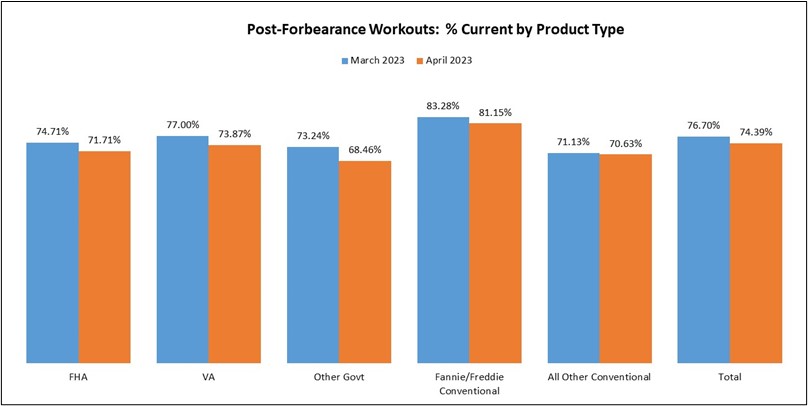 The Mortgage Bankers Association’s (MBA) monthly Loan Monitoring Survey [1] found that the total number of loans now in forbearance decreased by four basis points from 0.55% of servicers’ portfolio volume in the prior month to 0.51% as of April 30, 2023.
The Mortgage Bankers Association’s (MBA) monthly Loan Monitoring Survey [1] found that the total number of loans now in forbearance decreased by four basis points from 0.55% of servicers’ portfolio volume in the prior month to 0.51% as of April 30, 2023.
According to the MBA’s estimate, 255,000 homeowners remain in forbearance plans, and mortgage servicers have provided forbearance options to approximately 7.8 million borrowers since April 2020.
In April 2023, the share of Fannie Mae and Freddie Mac (GSE) loans in forbearance decreased two basis points from 0.26% to 0.24%. Ginnie Mae loans in forbearance decreased seven basis points from 1.18% to 1.11%, and the forbearance share for portfolio loans and private-label securities (PLS) decreased seven basis points from 0.68% to 0.61%.
“While the number of loans in forbearance continues to dwindle, there was some deterioration in the performance of post-forbearance workouts,” said Marina B. Walsh, CMB, MBA’s VP of Industry Analysis [2]. “About three out of four borrowers are remaining current on their post-forbearance workouts, but this is down from the average of four out of five borrowers that was relatively consistent in 2022 and into 2023.”
By stage, 34.4% of total loans in forbearance were in the initial forbearance plan stage, while 53.2% were in a forbearance extension. The remaining 12.4% were forbearance re-entries, including re-entries with extensions.
Total loans serviced that were current (not delinquent or in foreclosure) as a percent of servicing portfolio volume (#) decreased to 95.89% in April 2023 from 96.35% in March 2023 (on a non-seasonally adjusted basis).
“Overall servicing portfolios remain healthy, and some of the worsening monthly performance can be attributed to seasonal factors such as tax refunds that pushed up the March results and then normalized in April,” said Walsh. “MBA’s forecast calls for an economic slowdown and an increase in unemployment later this year and into 2024, which will impact loan performance.”

Of the cumulative forbearance exits for the period from June 1, 2020, through April 30, 2023, at the time of forbearance exit:
- 29.6% resulted in a loan deferral/partial claim.
- 18.0% represented borrowers who continued to make their monthly payments during their forbearance period.
- 17.7% represented borrowers who did not make all of their monthly payments and exited forbearance without a loss mitigation plan in place yet.
- 16.1% resulted in a loan modification or trial loan modification.
- 10.9% resulted in reinstatements, in which past-due amounts are paid back when exiting forbearance.
- 6.5% resulted in loans paid off through either a refinance or by selling the home.
- The remaining 1.2% resulted in repayment plans, short sales, deed-in-lieus or other reasons.
Total completed loan workouts from 2020 and onward (repayment plans, loan deferrals/partial claims, loan modifications) that were current as a percent of total completed workouts decreased to 74.39% in April from 76.70% the previous month.
Nationwide, the five states reporting the highest share of loans that were current as a percent of servicing portfolio include Washington, Colorado, Idaho, Oregon, and California. The five states reporting the lowest share of loans that were current as a percent of servicing portfolio include Louisiana, Mississippi, New York, Indiana, and Alabama.
The Bureau of Labor Statistics (BLS) reports [3] that total nonfarm payroll employment rose by 253,000 in April, and the unemployment rate changed little at 3.4%. Employment continued to trend up in professional and business services, healthcare, leisure and hospitality, and social assistance. Both the unemployment rate, at 3.4%, and the number of unemployed persons, at 5.7 million, changed little in April, as the unemployment rate has ranged from 3.4% to 3.7% since March 2022. Among the major worker groups, the unemployment rates for adult men (3.3%), adult women (3.1%), teenagers (9.2%), Whites (3.1%), Blacks (4.7%), Asians (2.8%), and Hispanics (4.4%) showed little or no change in April.
“A strong job market will boost earnings and household spending capacity, which is good for the housing market and broader economy,” added Realtor.com Chief Economist Danielle Hale [4]. “However, a too-strong market means the Fed has to tighten further, dampening that good news and running a higher risk of over-tightening. Today’s report falls a bit above expectations, and may undermine some of the early-week confidence that a pause in rate hikes is ahead. Fortunately, we have nearly another 6 weeks to go before the next Fed meeting in which we’ll see several more readings on the economy, inflation, and the job market. For home shoppers, this could mean somewhat higher mortgage rates ahead. But perhaps more importantly for home buyers and sellers, the labor market continues to support income-earning and consumer confidence, two necessary ingredients for home sales to occur."